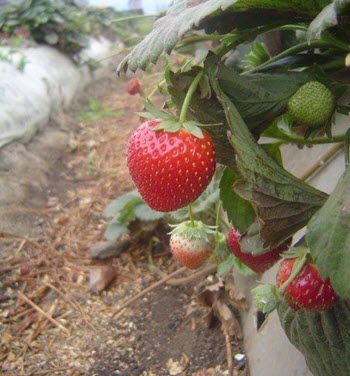The Prospects of American Strawberries
Comprehensive review summarizes the challenges, needs, and opportunities for strawberry growers
 Commercial field production of strawberriesCREDIT: Jayesh Samtani
Commercial field production of strawberriesCREDIT: Jayesh Samtani
A comprehensive review led by Jayesh Samtani of Virginia Tech and Curt Rom of the University of Arkansas encapsulates an understanding of the challenges, needs, and opportunities of strawberry growers across the United States. Samtani and Rom formed and gathered support from a team of 12 researchers from 10 different states as they embarked on an academic journey designed to generate an effective guideline essential for research, policy, and marketing strategies for the strawberry industry across the country, and to enable the development of general and region-specific educational and production tools.
Their findings are summarized in the article "The Status and Future of the Strawberry Industry in the United States," an open-access article published in HortTechnology.
The review divides the United States into eight distinct geographic regions, and an indoor controlled or protected environment production system. A common trend across all regions is the increasing use of protected culture strawberry production with both day-neutral and short-day cultivars for season extension to meet consumer demand for year-round availability.
All regions experience challenges with pests and obtaining adequate harvest labor. Increasing consumer demand for berries, climate change-induced weather variability, high pesticide use, labor and immigration policies, and land availability impact regional production.
The United States produces more than three billion pounds of strawberries each year, providing almost 20% of the world crop, and is a global leader in production per unit area. The farm gate economic value of strawberries is just shy of $3 billion per year. With that monetary strength, the US production acreage has increased approximately 17 percent steadily since 1990, with the largest expansion in Florida and California.
U.S consumption of strawberries has increased significantly during the past two decades, from two pounds per capita in 1980 to approximately eight pounds per capita in more recent years. Consumption is expected to continue to increase as a result of increased awareness of the health benefits associated with berry consumption, year-round availability made possible through domestic production and protected berry culture, increased imports, and improved cultivars.
The future of strawberry production will be dictated both by grower production needs and consumer demands for the fruit. The number of growers who have reduced the use of fumigants has increased. In those regions that rely on fumigants to control soil-borne pests and weeds, there is increasing interest in alternative treatments such as the use of steam, enhanced soil solarization, or hot water treatments.
Until the economic viability of these alternative treatments is determined, growers facing pest pressures at their production sites are continuing to use fumigation, despite regulations against it. Automation and robotics to assist with the more labor-intensive tasks of planting, maintaining, and harvesting will be further developed and used to expand both the regions and seasons of production, thus increasing consumer accessibility and reducing the use of pesticides and the corresponding environmental impact.
Samtani adds, "What started off as a discussion and a general idea between myself and Curt Rom certainly progressed into a benchmark review. From its foundation as a USDA-SCRI planning grant proposal (Planning to Increase the Productivity and Competitiveness of Sustainable Strawberry Systems), the initiative gained momentum over time through our exchanges of ideas and thoughts. This culminated into a workshop at the 2017 ASHS Annual Conference. Speakers were carefully identified, ensuring those with sufficient knowledge, experience, and expertise were chosen to represent the different strawberry production regions of the US. We believe that we have provided a great overview of the different strawberry-producing regions of the United States--a topic that has not been investigated and documented at a national level."
